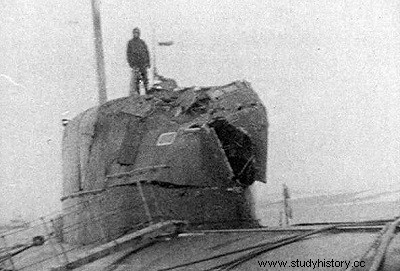
The submarine incident off Kildine Island refers to a collision between the United States Navy nuclear submarine USS Baton Rouge and the Russian Navy nuclear submarine K-276 Kostroma near the Russian naval base in Severomorsk, February 11, 1992. The incident took place while the USS Baton Rouge was engaged in a secret mission, apparently intended to intercept Russian military communications. Although the majority of sources claim that the American submarine had absconded, it is believed that neither the Kostroma nor the Baton Rouge were able to locate each other before the collision. /P>
Context
Immediately after the collapse of the USSR in the fall of 1991, uncertainty reigned among US intelligence services about the attitude of the forces of the former USSR, in particular the strategic missile forces that remained under Russian command. From the United States Navy's perspective, the operation was to keep tabs on major Russian nuclear submarine bases to find out whose control they were. During the Cold War, this type of espionage was codenamed Operation Holy Stone. Submariners dubbed these missions Operation Pinnacle or Bollard. Author Jeffrey T. Richelson argues that the espionage operations had continued despite the fall of the USSR and that the 1992 incident was part of the operation. This intelligence gathering was aimed at tapping Soviet submarine communication cables, recording the movements of Soviet submarines and observing the maneuvers of the Soviet fleet for fear of ballistic nuclear tests.
Development of the incident
The collision between the two submarines took place at 8:16 p.m. local time on February 11, 1992 just over 19.3 km from the Russian coast of Murmansk, in waters considered by the United States as international and by Russia. like 8 km inside its territorial waters.
The mission of the USS Baton Rouge would have been to acquire data on anti-submarine surveillance devices. The American press at the time claimed that the submarine controlled wireless traffic between Russian bases, while their Russian counterparts claimed that the two submarines had engaged in a mutual hunt, a view also supported by a number of Western sources. According to naval analyst Eugene Miasnikov, the anti-submarine surveillance devices deployed by Russia along its coasts make the first possibility implausible. He also claims that the second possibility is improbable and that the collision was only due to chance. The crashing waves and shallow waters of this region of the Barents Sea could indeed, by creating too much "noise" around them, have prevented the early detection of the two submarines, which at the time of the incident were only using their passive sonars.
Miasnikov argues that Los Angeles-class submarines are unable to detect acoustic signals from targets inside a 60-degree cone aft. The most likely scenario would be that Kostroma approached Baton Rouge from behind. The Sierra-class sonar is also "deaf" to rear directions, its usual pattern of acoustic seeking moving along a looping course. The incident, however, raised speculation that Russian attack submarines are capable of avoiding passive acoustic detection, at least under certain conditions, such as depending on the environment.
Both submarines sustained damage, but no casualties were reported. Russian and American air surveillance reports, on the other hand, agree that the front part of the Kostroma was damaged. Russian Navy sources say they found pieces of composite material from Baton Rouge's anti-sonar tiles. The United States Navy claims that, other than a few scratches, dents, and two minor cuts to her tank, the Baton Rouge did not sustain significant damage, but specifies that this type of incident was in any case considered as serious, any rupture of the hull of the USS Baton Rouge compromising its resistance to pressure. The sub will be decommissioned on September 17, 1993, although some sources say it had already been decommissioned less than a year after the incident, in January 1993. According to Arkansas curator Gregory Stitz Inland Maritime Museum and some European sources, the United States Navy had not wished to repair the hull, given the expected cost. Russian Navy officers say the US submarine was beyond repair after the collision. As for the Kostroma, she was withdrawn from service on March 28, 1992 to carry out repairs, which were completed on June 29 at the Nerpa shipyards in Snejnogorsk. She was later renamed Krab, before returning to her original name in November 1996. After a major overhaul again, the Russian submarine returned to service in 2005.
Political consequences
The incident produces intense embarrassment in Washington. Russian diplomacy complained about the collision, and the Pentagon quickly acknowledged that it had taken place (contrary to official policy until then). A meeting between Secretary of State James Baker and Russian President Boris Yeltsin was arranged immediately after the incident. The Russian Navy has accused the United States of continuing its intelligence operations in Russian territorial waters, despite the end of the Cold War. This chain of reactions forces the United States Navy to stop some of its underwater activities off Russian bases, such as tapping underwater cables or intercepting wireless communications. This measure, however, did not prevent a later incident in March 1993, when the USS Grayling collided with a Delta-class submarine, K-407 Novomoskovsk off the Kola Peninsula. /P>
